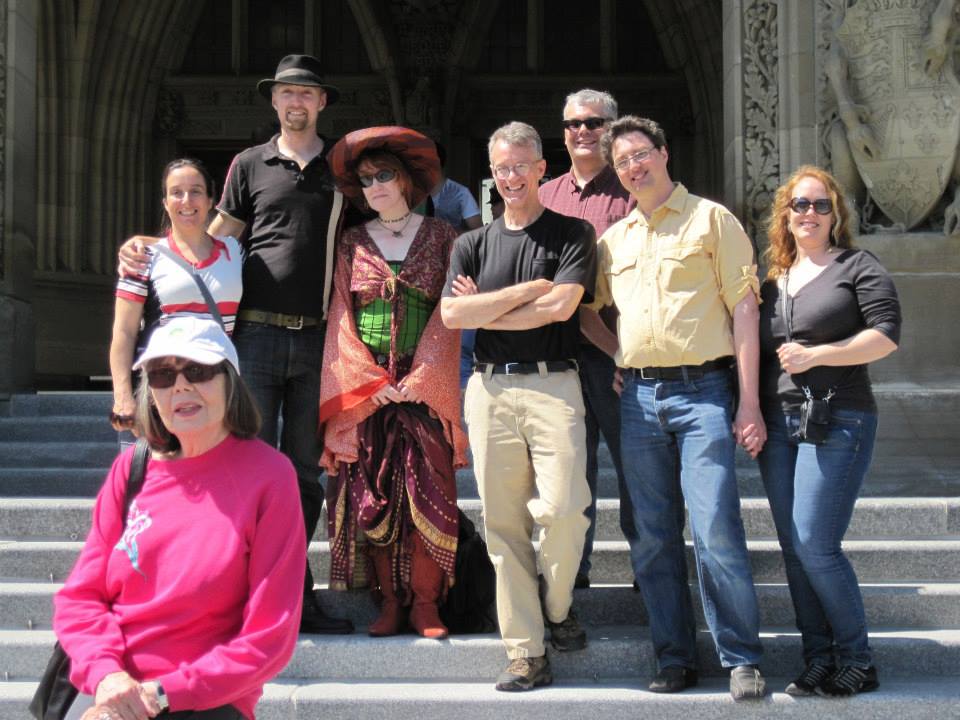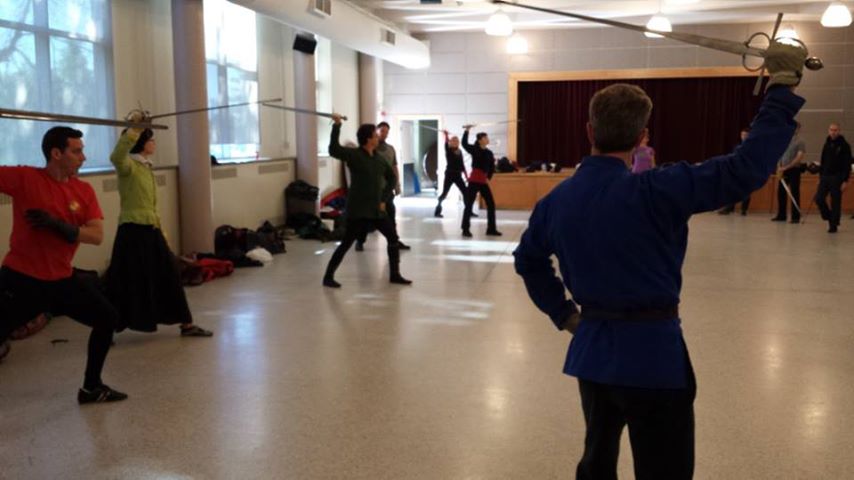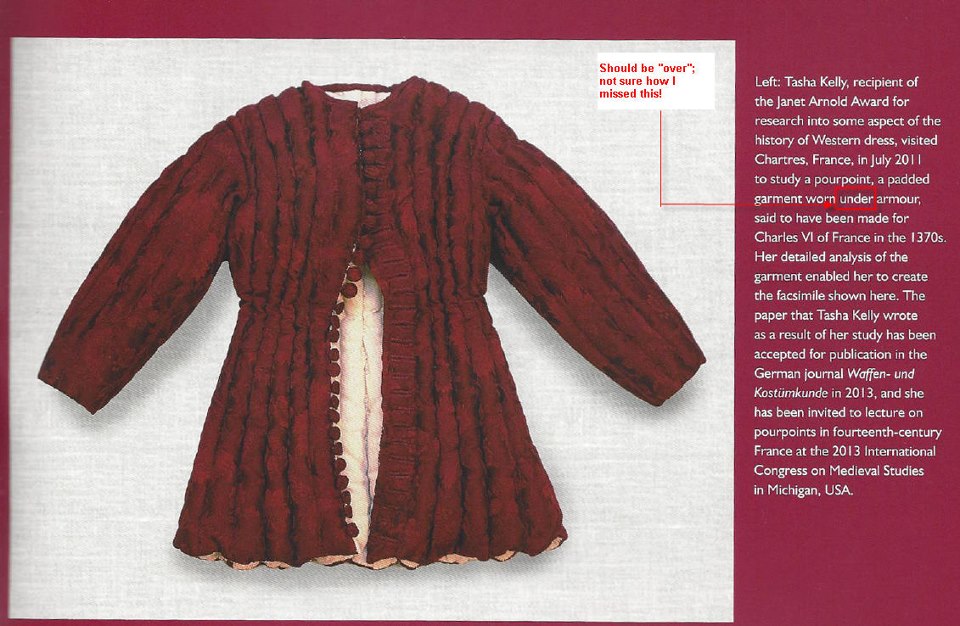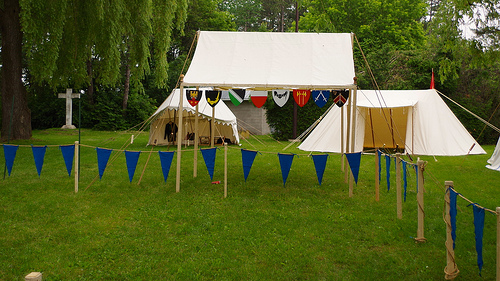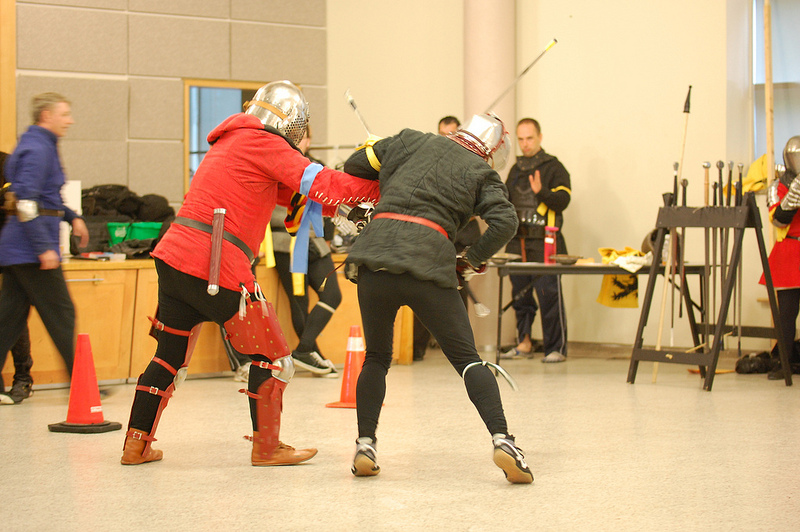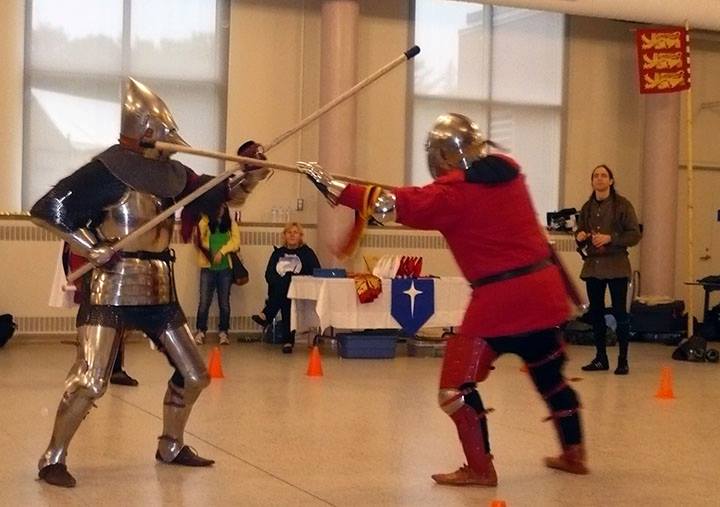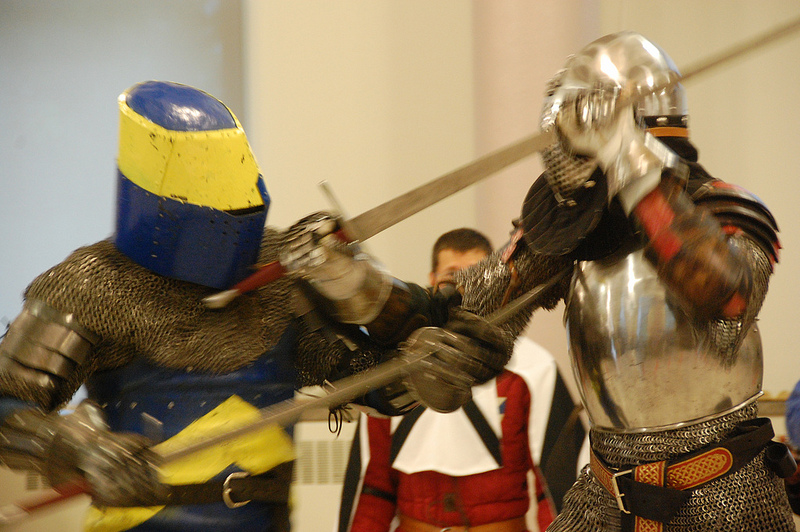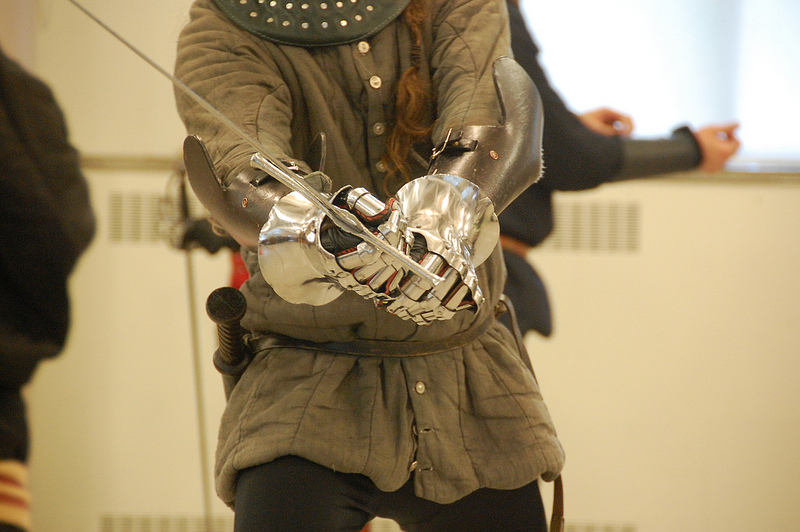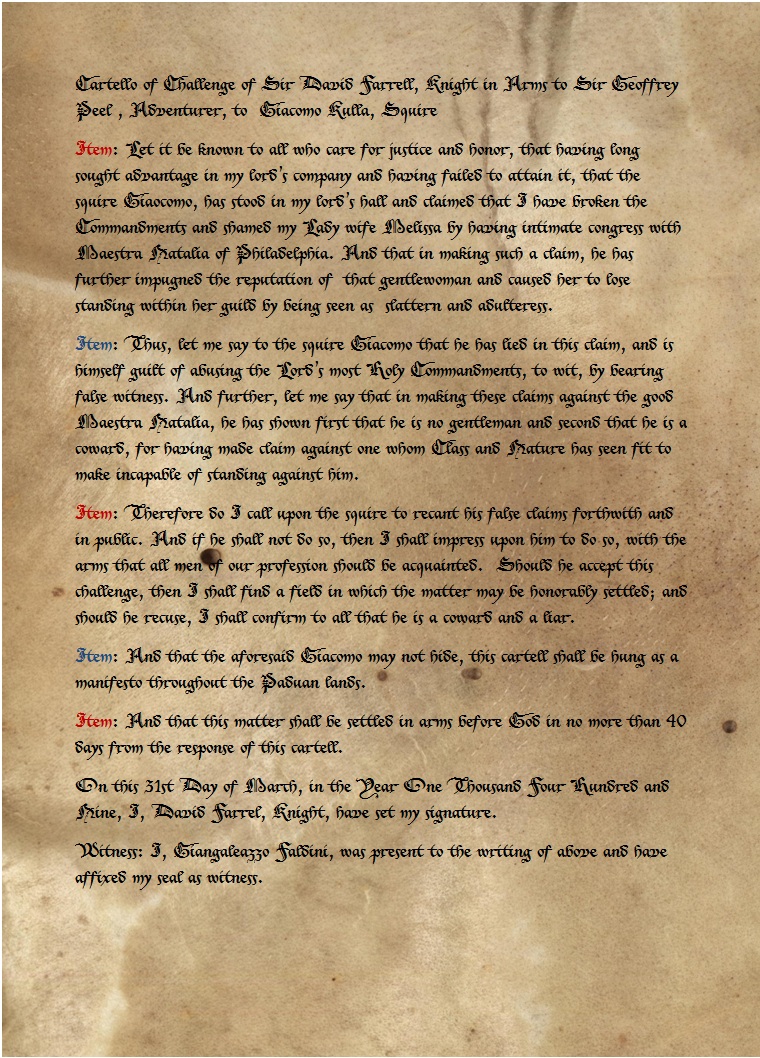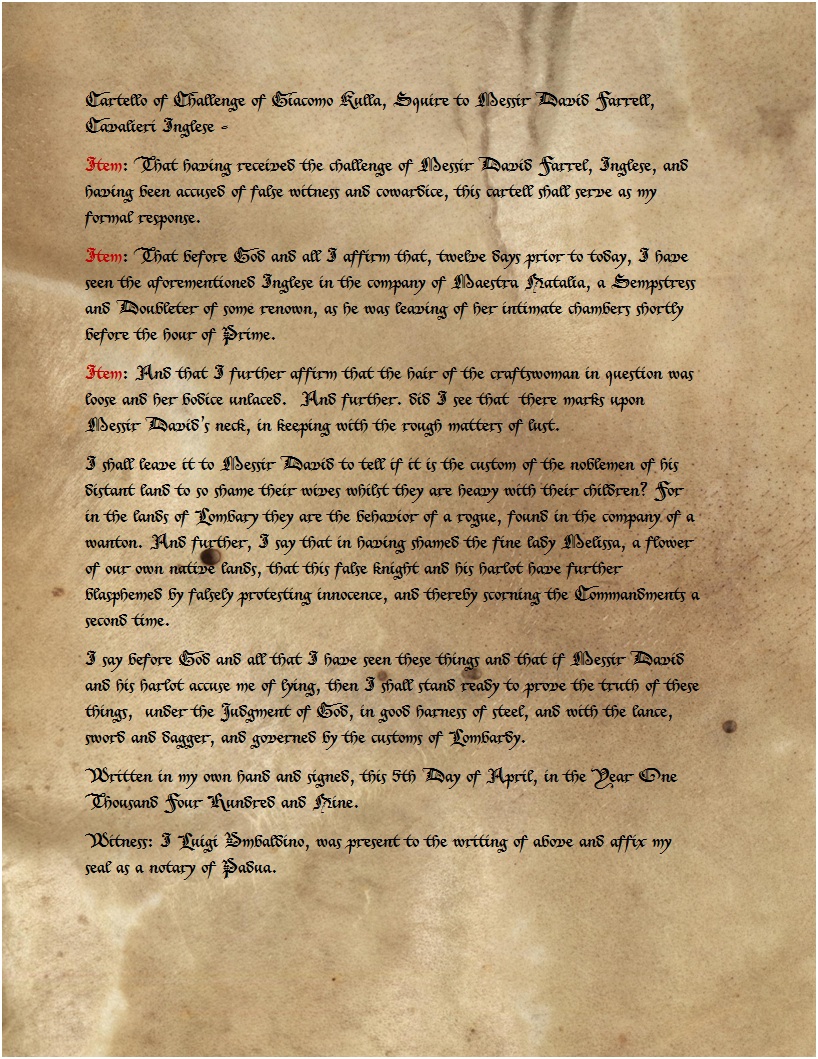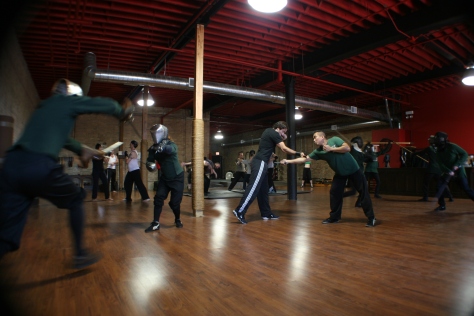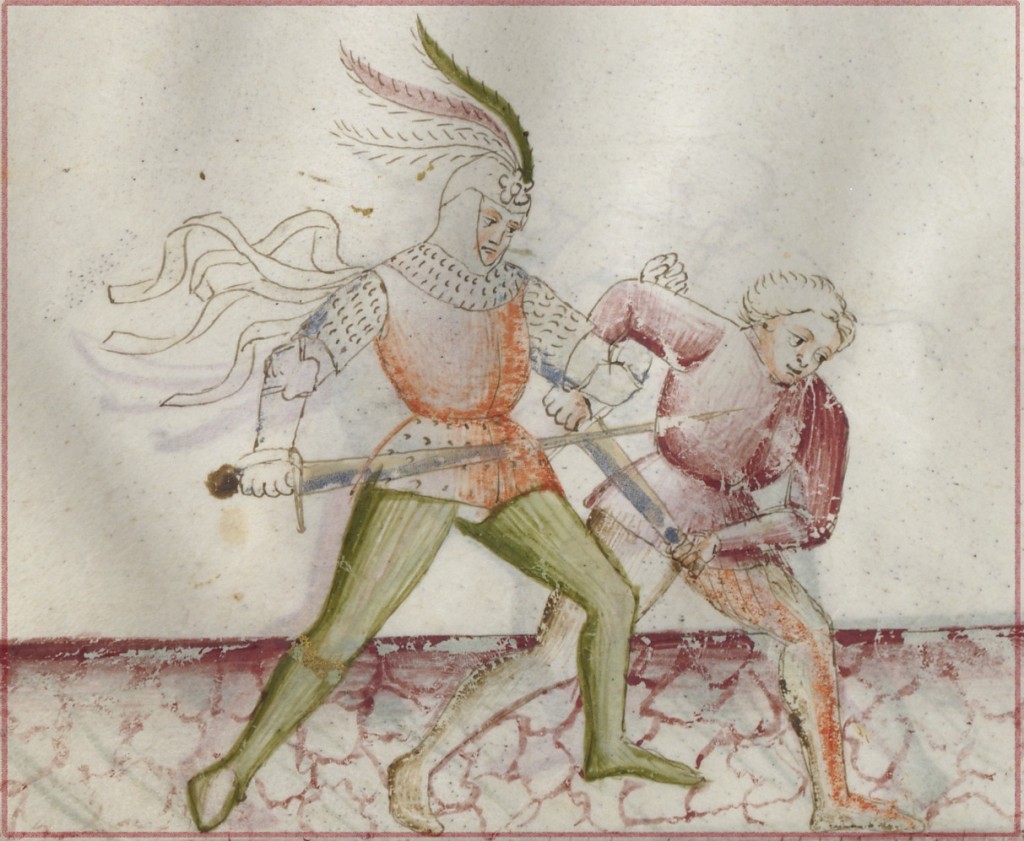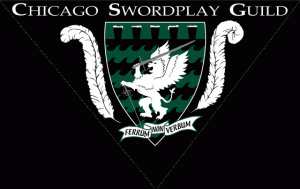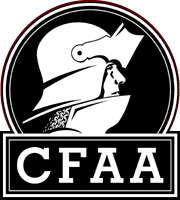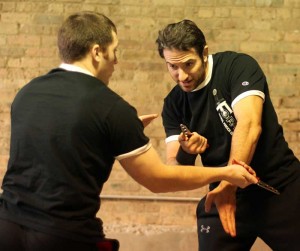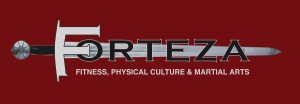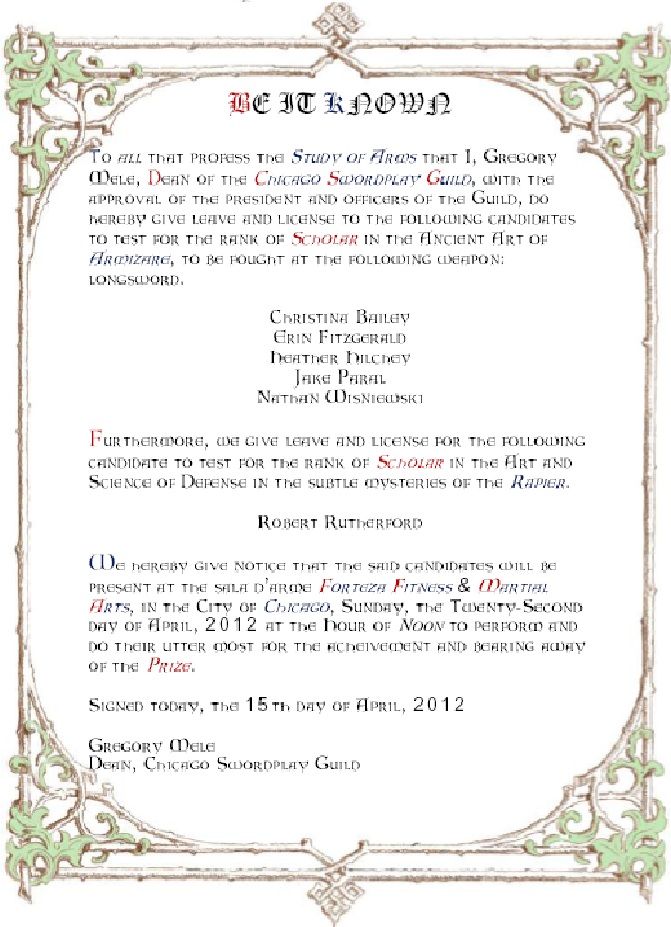by Gregory Mele,
In the 14 years since the Chicago Swordplay Guild was founded, I’ve sought to keep martial arts politics off of its website, even when I’ve been in the thick of things myself. When we redesigned the website to include a blog, we’ve focused on event notifications, reviews, demos and training material. But the broo-ha-ha in the last two weeks over the creation of an Historical Fencing Master program by the United States Fencing Association (USFCA) is sadly killing that 14 year streak.
The short strokes are simple: after an on-again, off-again attempt by the USFCA to create a program for certifying teachers of historical swordsmanship, led by Maitres des Escrime Walter Green (for those not in the know, MdE is the title given to modern fencing masters), Dr. Ken Mondschein approached the USFCA about joining the project. Ken has explained his rationale in an open letter, best summarized as:
It has long been my belief that to grow and flourish, the study of Historical European Martial Arts needs both greater professionalism and recognition from established organizations. Being an academic, I live in a world where credentials are very necessary. Many others have seen how such recognition would be beneficial to their own efforts.
Now, before I say one more word – I personally think that while Ken’s role was a well-intentioned, but misguided effort, I don’t think the program was viable, I don’t think the USFCA were the people to do this, and I don’t think their motives are particularly pure. Further, at this point, the likelihood of anything good coming from it is probably somewhat less likely than using an alembic to turn lead into gold.
OTOH, if the USFCA was going to attempt this, Ken’s qualifications were good ones:
- He has been a student of classical and modern fencing for about 20 years, having already achieved both a moniteur (instructor) and prevôt (senior instructor) license from the USFCA;
- He is a student of la canne and grand batôn, one of the other surviving weapon arts of Europe;
- He has been a student of French smallsword, Italian rapier and Italian longsword for nearly as long as he has fenced, trains and fights in armour and is learning to joust.
- He is a PhD in Medieval studies and Fulbright Scholar, who discovered the fourth Fiore text and paid with own grant money to have it photographed;
- He reads French, Latin and Italian in their modern and medieval forms;
- He has published three works on historical swordsmanship and has two more in the works;
- He has organized and presented papers and sessions on HEMA at the premier medievalist conference in the United States.
- He has taught classes on applying classical fencing pedagogy and interpretive classes on rapier, smallsword and longsword at various HEMA events in the United States.
In short, he’s not a hack, this isn’t a passing fad with him, and there is very, very little reason to suspect his agenda was anything more than what he claims it was. I can add that he approached a number of HEMA folks in the US to participate in the program, and was soundly refused. (I will explain why in a later post.) Last year, several American and European swordsmen found out about the program and decide to launch a series of accusations on that most serious of academic fora – Facebook – upset that they weren’t consulted. All I can say to that is “Boys, get your knickers out of a twist and consider that in some cases a) you aren’t in the US – so the USFCA frankly wasn’t interested in what you had to say, anymore than the FIS in Italy or AAI in France cares what I have to say, b)maybe Ken doesn’t know you, or maybe your street cred isn’t as good as you thought, c) he was one triad of a committee and the junior member at that.”
HOW TO DESTROY A CERTIFICATION PROGRAM IN TWO EASY LESSONS
Regardless of how it got there, now the program is live, and as the USFCA usually does things, they made a hash of it. Besides Ken, the other two members on the committee are not well-known in HEMA circles. One is Jerry Benson, a fencing coach of some reputation who has students deeply involved in HEMA practice – I do not know if he saw this as a way to work with his students to create something better or if they approached him, but he does not deserve to be called “Jerry the Salesman” because he had the gall to give a lecture on how to develop successful fencing programs; anyone who has to pay rent to keep a studio open for a large club, rather than train with four buddies in the park gets that reality.
Sadly, the third member is more problematic – another sport-fencing master who has a “pedigree” of credentials that set off every Bad Budo warning buzzer, from mail-order ninjutsu, to an 8th dan in a system of his own devising. I am sure he got his USFCA credentials legitimately, but his centrality to the program at least shows the organization’s lack of understanding of martial arts, and martial arts politics. (Go figure, they train teachers in an Olympic sport.)
To have had any hope of legitimacy with the “community” they were hoping to attract, the program’s first candidates should have had to publicly go through all three certification stages themselves, publicly. Instead, the USFCA chose to promote the three members of the committee directly to Maitres des Escrimes Historiques, thereby giving them the authority to run the program. Their choice, but an incredibly stupid one.
So in the end, Ken’s idea was laudable but dead-on-arrival in my opinion (I will explain why in a separate post) even before politics got involved, but once they emerged there was no hope whatsoever.
THE LEAGUE OF EXTRAORDINARILY CATTY FENCERS
And so we have the digital gnashing of teeth, the tearing of breasts, and the prophesized end of civilization as we know it, as legions of electric foil-wielding fencers line up in order of their tournment seeding to plug in their longswords and lead us down the brimstone path to martial arts hell….
(Sorry, I got lost in my own hyperbole for a moment there – the discussions about tournament seeding and electric longswords came from within the HEMA community! )
But you would think that was precisely what would happen as various corners of the HEMA world exploded in rage over a certification by the Sideshow Bob of American Fencing, calling Ken Mondschein the self-crowned Napoleon of historical fencing, a liar and all sorts of the charming things oft cited by emboldened, digital warriors. I am not sure that a debate about gay marriage between Bill Mahr and Rush Limbaugh on Pierce Morgan’s show could have more shamelessly played for the low blow. (Sigh… sure, I got my licks in there, too. The flesh is weak.)
While Jerry is now the traveling snake-oil peddler, Ken is the traitorous cuckoo in the nest, and apparently, all good Dead Fechtmeister-Fearing Men must roast him and tear his flesh, because he “was warned” – by no less than the Godfather of HEMA himself, who said “thou shalt have false Masters before Me “. He also vowed to never adopt such a title himself, which seems noble and bold, until you realize that as it is a teaching title, and he has neither a school nor students, that isn’t saying much.
(About this point you might be wondering why it is morally wrong to try and create a certification program that no one is compelled to join, but OK to personally attack someone because they defied your wishes , when you are not their teacher, nor the head of any certifying body, nor even a researcher with a substantial published body of work. If you are wondering that, it is probably because your parents probably raised you right. But I digress.)
What is fascinating, and disheartening, to me, is that while these men in their 40s and 50s engage in what is little more than internet hazing and bullying they seem to ignore the obvious:
- some of these same folks were victimized by rumor-mongering, innuendo outright lies and similar attacks by John Clements, the ARMA director, directly leading to the formation of their own clubs and organizations;
- another subset of these folks have thought it in poor taste to call out those problems with the ARMA director, and felt that as Europeans “that is the Americans’ problem”;
- some of these same folks criticized myself and others when we revealed that Andrea Lupo, the founder of both the Federazione Italiana Scherma Antiqa e Storica (FISAS) and the International Master at Arms Federation (IMAF) was a fraud who had made up his entire martial pedigree, and most of his personal background, inventing the name of one master and claimed false credentials from another, because it was “no one’s business but the Italians” – even though Mr. Lupo had been trading on those credentials at seminars in the USA, Canada and UK as well.
- some of these same folks thought it was shameful and “bad for the art” to “publicly air dirty laundry” when it was revealed that the owner of the now-defunct Chivalry Bookshelf had defrauded his authors of their intellectual property and their royalties to the tune of tens of thousands of dollars, now see no problem in spending hours publicly ridiculing, personally attacking and mocking a man who never did them a lick of personal harm – and whom they never once tried to talk to privately.
- at the same time that they were lambasting the USFCA for appointing its first masters with a lack of transparency, some of them were instituting a certification program in which the first instructor was certified out of the public eye.
STRAWMEN OR DOMINOES?
Now, so as not to paint with too broad a brush, there are also legitimate concerns being raised with measured thought, polite language and an honest attempt to present the position without crucifying anyone. The best summary of this is Roger Norling’s blog post. If you’ve cared enough about this subject to read my post, you should read his for counterpoint.
At the center of the more reasoned arguments is a fear of the size of the USFCA and its creating an immediate cadre of “sport historical fencers” who will outnumber the rest of us. I have heard the argument, and I encourage you to read Roger’s concerns, rather than my paraphrase. All I can say is that I think these concerns are born from a misunderstanding of what a genderless, toothless entity the USFCA really is. It’s not going to happen, and the reasons are simple:
- Most fencers could care less about martial arts of any stripe – they are engaged in a sport;
- The USFCA has no authority over the USFA and little influence;
- The USFCA failed to even take over classical fencing in America, which at least ostensibly is related to modern fencing;
- The certification, even if successful, has no unilateral curriculum attached to it, and thus still does not impact what people teach;
- There are hosts of fencing coaches – modern fencing coaches – today who are not certified by the USFCA, and the USFCA has had no ability to prevent them doing what they do.
“I’M (MAESTRO) SPARTACUS!”
Beyond the fear of a domino effect, the other problem is apparently using the tile of “Master”, probably the most over-discussed and over-valued word in our community. We know that this was a title used by trade guilds to mean someone qualified to teach his art to others, under his own auspices and no more. We even have the qualifications used in Germany, England, Spain and the New World, and frankly, at least the German qualifications to that vaunted titled are not all that impressive once you read them. Yet the idea persists that somehow the Master at Arms profession degenerated in the 18th and 19th century, whereas their 15th and 16th century counterparts were living engines of death and destruction. As such, certainly no one would ever use that term today….
Or maybe, as most HEMA folks seem to have become involved in the activity in the last decade, they just don’t know their history. You see, we have plenty of modern masters of HEMA:
- Terry Brown reconstituted in the Company of Maisters of Defence in the 1990s, teaching a strictly English curriculum of martial arts, and requiring his students to go through the traditional grades of Scholar, Free Scholar, Provost and Master, with the required years spent in each. Terry has long said that you can’t create a provost without a master, so when recreating the Guild, he listed his research and accomplishments and played the prize against all of his other students, stating that this was done “for want of other Masters to play against”;
- Alberto Bomprezzi received instruction from a variety of sources, including the aforementioned Andrea Lupo, but adopted the title based on his accomplishments in establishing the Asociación Española de Esgrima Antigua, a federation of schools throughout Spain teaching a single, unified curriculum and including some of the leading lights of research into Iberian swordplay. He is a regular teacher at British and continental European HEMA events;
- Although he does not use it externally, Devon Boorman’s title with Academie Duello is Maestro d’Arme. Devon runs the largest HEMA school in the world, with a comprehensive curriculum, an weekly video lessons for students who are training alone or with one or two friends, and has traveled around the world teaching and fighting.
- Maestro Francesco Loda also was taught by Andrea Lupo, before going his own way, developing his own curriculum and heading the well-regarded Academia Romana d’Armi, which has since become affiliated with the Italian Fencing Federation (FIS). Maestro Loda is also apparently welcome at European historical fencing events.
- Maestro Massimo Malipiero was made a Magistro Re and Maestro di Scherma Antiqa by the Italian Accademia Nazionale di Scherma in 1999, as was Giovanni Rapisardi, and the program has gone one to create several other masters or submasters – “Magistri”.
I only have met the first three men on this list in person, but what all of them have in common is that:
- they use the title because that is what they do: they are teachers of martial arts, trained fighters, and teachers who have developed a method to teach other teachers;
- none of them seem neurotic or even particularly concerned about the title, usually going by their first names;
- all of them can do in practice what they show in class, and research, fight and teach at a high level of effectiveness.
Consequently, to my mind, they are welcome to call themselves Masters at Arms, because they fulfill that function and they have proven their abilities to fight and to teach – even when self-taught or when some of their own teachers were dicey. But they are still using the sacrosanct title of Master at Arms, so why aren’t swordsmen gathering in the streets, longsword feders and torches in hand? Why do those most upset about the USFCA also seem to grant them a pass? This has been explained to me that the USFCA case is “different”, because the USFCA is a major sports body (one might ask, major relative to what) and therefore could easily “appropriate HEMA” in the USA and create a chain reaction
IF A TREE FALLS IN A FOREST, AND YOU LIVE ON THE PLAINS, DOES IT REALLY MATTER?
Unfortunately, global warming is real and will probably alter life on this planet radically in the next century. Fortunately, whether or not there is credible Historical European Martial Arts still on the planet when that happens will probably have less to do with the USFCA then it does climate change. You see, fencing in the USA is not governed by the USFCA, but by the United States Fencing Association (USFA) – the actual American branch of the Federation International Escrime (FIE). The USFCA can’t dictate what the USFA does and the two organizations don’t get along terribly well. OK, I am being kind: remember I said that the USFCA was toothless and neutered? Well, most sport fencers who are even aware that it exists consider it something of a joke. On the other hand, the Accademia Nazionale di Scherma is the Italian equivalent to the Coache’s Association and much more closely aligned with the Federazione Italiana Scherma (FIS)which is the Italian USFA equivalent.
And guess what?
No, they aren’t going to follow the USFCA’s lead and create an historical fencing program, because they already have a Maestro di Scherma Antiqa program, with multiple ranks – founded under Giovanni Rapisardi and Massimo Malipiero in the 1990s. And just like the USFCA program, you pay for certification and certification training, with set course books and specific required reading, which just happen to be editions of the core texts (Fiore, Marozzo, Capoferro, Scorza e Grisetti and Parise) created by Rapisardi and Malipiero.
The first Maestro rank was granted in 1999 and I lived through the hue and cry. “Oh no, the Naples Fencing Academy is now licensing historical fencing, and they are part of the FIE – this is the end of historical martial arts in Italy. Then France will follow, and Germany, and …”. I would point out that somehow the Accademia Nazionale now also licenses kendo in Italy, so if anyone was going to make a power grab, this would have been the guys to do it. And yet, fourteen years later,while there are probably far more people licensed by FIS’s historical fencing program then the USFCA will ever see, FIS isn’t even close to owning historical fencing in Italy. Sala d’Arme Achille Marozzo is clearly larger, so is Nova Scrimia, and ironically, so is FISAS – an organization founded by Andrea Lupo – the man who made up a mythical master and his entire martial arts biography, which is far beyond any of Walter Green’s mail-in certificates.
Where’s the outrage? There is none, because a) this all happened 15 years ago, when most of those so upset didn’t know about HEMA and b) it has had zero influence on anything – HEMA has grown vigorously and in a variety of directions, including in Italy itself. In fact, some of the folks in Europe most terrified and outraged by the USFCA program on Facebook have those FIS salles listed on their “likes” page.
So perhaps the problem is that Ken and Jerry have the wrong friends, or perhaps the real issue is that all of these other masters have been engaged in Italian, Iberian or English swordsmanship, whereas the bulk of the HEMA community crowds around the Liechtenauer tradition. But since the USFCA program is tradition agnostic and separated from Europe by 5000 miles, now someone might get that diploma and call themselves a….Fechtmeister! Quick, save the Fatherland…er…even though we’re American, Belgian, Dutch, English, Swedish, French, or…
Maybe that is why I don’t care about this – there have been people claiming the title of master at arms in my given focus for over a decade and a half – some rightly so, at least in my opinion, and some laughably so. But neither good nor bad has had a lick of impact on what I do, how I do it, or who I do it with. Fiore dei Liberi wrote:
I, Fiore, know how to read, write and draw, and have books on our subject, a subject that I have studied for over forty years. Yet, I don’t consider myself to be a perfect Master of it, although I am held to be such by some of the great lords whom I taught. Let me just say that if I had spent the same forty years studying law, jurisprudence or medicine as assiduously as I have studied the art of arms, I would be a Doctor in each of these three disciplines. And I have undergone great pain, labor and expenses in being a good student.
That’s the most I can do, and accept that the path to mastering an art is just that – a path – that was never mean to end with a title, merely acknowledge that you could initiate others on that journey.
Despite my honest disgust at how Ken has been treated, and despite my ribbing here of some of my friends who study German martial arts, I cannot recommend, endorse or anyway accept the qualification or the program offered by the USFCA, and I truly wish that my friend Ken had not wasted his time, efforts or own hard-won credentials on a program that really could never do what it needs to do, even in a perfect world. Respect is earned, so someone being a USFCA “Master of Historical Fencing” means as much or as little to me as how they behave on the mat, and what they bring to the classroom. Ken’s motives were honest, his behavior consistent, and while I declined to be involved and continue to believe the effort was misplaced, he is a friend, a fellow-worker in the mines, and an honest member of the community. I cannot say the same about some of his most vocal critics, who have accomplished less, produced less and yelled the loudest, using personal attack, mockery and invective as a diversion from the obvious question of “and your authority to speak ex cathedra or sit in judgment comes from….?”
By their fruits shall ye know them. A lot of plants have been planted in the last few weeks and we’ll be seeing some misshapen bulbs for some time to come. But I know this much, when Ken wrote:
First, it has been my hope that the USFCA certification could establish both an impartial credential and an invitation into a collegial community outside the politics and divisions that so plague HEMA.
The last two weeks have just shown him what a charming delusion that was.
FURTHER READING
As the tempest swirls in its teapot, the curious might want to see a few other points of view:
Guy Windsor’s blog discusses both the controversy and why the program was flawed from the onset.
In an effort to create something good out of the madness, Jens Kligman has created the Marxbruder Facebook group to humorously – and yet seriously – discuss the old German fencing guild, its testing requirements and to debate how the Guild could be recreated in the modern day.
As the lightning rod for the debate, Ken Mondschein has tried to explain his position in an open letter.
While most of the debate has swirled about Facebook and other social media, as I said Roger Norling has tried to present the other side’s arguments sans diatribe or personal attack on his blog. He and I agree about the program’s flaws, not the threat it represents, but his positions are worth reading and considering.
Answer: Sometimes you just say it.
My last post was about the hullabaloo regarding the recently instituted Historical Fencing certification program being developed and promulgated by the United States Fencing Coaches’ Association (USFCA). I focused on a need to separate the character assassination of the members involved from a critique of the program itself (as was also done in counter-point here), and to express why I disagree with the idea that the program is a “threat” to other folks studying and teaching HEMA in the USA.
At the end of that post, while defending Ken’s motives in being involved, I also stated: “I cannot recommend, endorse or anyway accept the qualification or the program offered by the USFCA, and I truly wish that my friend Ken had not wasted his time, efforts or own hard-won credentials on a program that really could never do what it needs to do, even in a perfect world.”
Ken knows I don’t like the program, and he knows I don’t support it, so that wasn’t a surprise, although probably a disappointment. I didn’t expect that just a few hours after posting, I’d be getting a ton of private emails about why I think the USFCA program is a non-starter, but fortunately, I was already preparing a post to explain just that. Add a little insomnia and you get your follow-on post.
Full disclosure: Ken approached myself and several others to participate in this program, or at least provide insights and feedback, and we turned him down. So I can’t claim that we didn’t have a chance to participate. I won’t speak for others’ motivations, but my personal reasons for not being involved were simple, and fall upon three basic rationales:
1. I don’t Believe in Generic Certifications.
Creating a Master of Historical Swordsmanship license is like creating a Master of Kali or a Master of Kenjutsu license. Which tradition of those arts? Under whose authority? With what weapons? But in some ways it is even worse, as Western arts cover centuries of development and innovation in which not only the weapons, but the culture, mindset and combat context radically changed. Yes, duels were fought in the 15th century and the 18th, but they were fought with radically different tools, radically different rules, and often for radically different objectives. Mastery of one weapon does not convey mastery of the other, before we even begin to discuss the particulars of tradition.
Further, when we do move into the realm of pedagogy, we still have some problems. Although we can argue that at a very real level an attack is an attack, a parry-riposte is a parry-riposte, etc., that does not mean that the tactics of those techniques are the same, era to era or tradition to tradition. The French tradition, from which modern fencing primarily derives, for example, favored the parry-ripsote as the foundation of good fencing, while the contemporary tradition continued to make stronger use of counterattacks, as had been used with the old rapier. Take a walk backwards four centuries and cross into Germany and you have five key blows, the so called Meisterhau, of which at least four are indisputably counterattacks and a teaching paradigm that builds on what happens when the opposition has been successful, but the attack did not land. Nevertheless, the intention is to immediately take the initiative with an action in-tempo, forcing the attacker onto defense. Is such a thing unknown in modern fencing? No, of course not! But it is given different priority. Change the emphasis and you change the art.
Simply put, just because it is a sword doesn’t mean it is used the same way every other sword is, or even the exact same way that the same sword is used in every tradition. The devil is in the details, and saying that “using a longsword is using a longsword” is like saying that using a katana is using a katana, and since it and a longsword are both two-handed swords, they must be precisely alike it is only true at the broadest level.
Now, there is an obvious work around to this – a USFCA “generic” historical longsword, rapier, etc curriculum, meant to be used as a modern lingua franca for students. Honestly, if I have to explain why that is a phenomenally bad idea, or why it directly plays into the concerns of the programs harshest critics, you can probably stop reading this post now – we’re talkin’ different languages. But try this: find a nice old-school Kyukushin Karate dojo and ask them what they would think of a pan-karate teaching certification, that included not only Okinawan Karate of all styles, but Japanese styles and Tae Kwon Do (which originally derives from Karate). If you are worried about getting kicked in the head for your troubles, try it with something safe like Aikido or Tai Chi and just suggest the certification apply equally to all flavors of that one art.
(Hey you OK, buddy? Need an ice pack? Oh, you thought I was serious when I said that was a safe idea? Yeah, people are kinda proprietary about their art – funny that. Good thing you didn’t talk to the guys with the bolos….)
2. The USFCA isn’t Qualified to Create a Certification in Medieval or Renaissance Swordsmanship
I will let those who study 18th c backsword, broadsword, smallsword and sabre determine how well a coaching program for Olympic fencing can be applied to their arts, which are the direct antecedents of classical fencing, which in turn is the antecedent of the modern sport, and speak to the arts I study. Simply put, although the famed Lugi Barbasetti was correct when he compared the martial art of Fiore dei Liberi to “Japanese wrestling or Roman pancration”, his inability to also recognize the relationship of those arts to fencing speaks directly to our point. Barbasetti was a true fencing master, learning and teaching in an era where the sword was still being used in the duel, in highly-watched, high-stakes exhibitions, and occasionally, on the battlefield. Even so, he could see little in pre-rapier fencing that was fencing and not just wrestling and bashing – something with which he had no experience.
Now imagine his modern descendents, trained to view fencing as an Olympic sport, fought for points, assessing the longsword – a weapon used with extensive disarms, grapples and hilt-strikes, all built around a foundation in grappling and dagger-combat. How can the USFCA possibly ascertain the quality of that wrestling or its instruction? How can they assess it for being taught safely? Short answer – they can’t; it is well beyond their skill set. So any certification for a Maitres des Escrime Historique would need to either a) be done in conjunction with a second organization, such as one of the state Collegiate Wrestling associations or b) restrain itself to looking at only simple wrestling techniques made at or on the blade, such as hilt grabs, disarms and envelopments of the blade with the arm.
Of course, the former solution won’t happen – it was probably hard enough to engage one Olympic/collegiate sports association, good luck engaging a coordinated program with a second, especially when they are currently more focused on not being phased out of the Olympics, not to mention an increasing number of American high schools. That leaves the second option; just keep the wrestling to actions done against the blade. Problem is, the moment you do that, you just neutered the “H” in your Historical European Martial Arts (granted, large parts of the modern HEMA “community” do that, too, but that is another can of worms).
So we already have a major disconnect before we ever consider that, prior to the 1650s, there was an assumption that a swordsman would be well-versed with not only the sword, but the dagger, basic unarmed defense and possibly a polearm or two. Meanwhile, before the 1550s, the art was incomplete without at least a working knowledge of the sword, dagger, wrestling, some form of staff weapon and armoured combat – all of which are well beyond the USFCA’s expertise or qualifications to judge.
You simply can’t study 15th c swordsmanship and understand it at a teaching level without include wrestling, dagger, polearms and at least some understanding of armoured combat. Likewise, you can’t study 16th c German martial arts and ignore the staff, dussack or messer or rappir, or train in Bolognese fencing without moving beyond sword and buckler. That is not how the arts were designed and not how they were meant to be understood or taught. Put another way, you can study whatever you want, but you can’t master these arts without doing that and you certainly can’t certify someone to teach it.
3. You Can Certify “Good Teaching” Without Knowing About the Particulars of Someone’s Art
The pushback to the first two points I have raised is that “we are developing good pedagogy and using the exemplar weapon as a way to promulgate that pedagogy”. This seems almost as reasonable as the “non-denominational” certifications for instructors given out by HEMA organizations such as the British Federation of Historical Swordplay or the HEMA Alliance. While I have good friends in both of these organizations, in many ways I find their certifications even worse than the USFCAs. Consider this: the USFCA at least does have a standard, professional system for developing instructors, pan-HEMA groups are associations of clubs, many led by home-grown instructors who may or may not have had a lick of formal martial, sports or pedagogical training, and whose member bodies usually cover a diverse array of arts. The British Federation seems to have gotten around this by “a fixed set of criteria that are in line with the UK Coaching Certificate “. I have no idea what that means, exactly, and not living in Britain, it really doesn’t matter much to me, but like the HEMA Alliance program, you still have the idea that you don’t have to teach a particular art or have an accepted interpretation (how egalitarian!); you just need to publicly present your curriculum, teach it, answer some tough questions, and meet some sort of agreed upon “standard”. (I presume this is where being in line with a Coaching Certificate comes in.)
This sounds brilliant – the guys who care about the art are certifying the people teaching the art! Woo-hoo, we’ve done it!
Too bad in reality you are right back to the problem of point one, only now, with potentially a new problem: the self-trained certifying the untrained in arts they know nothing about. This falls under a fallacy of “I know good teaching when I see it”, which is true on the surface, but the problem is, good at teaching of what? And that is the next place where any pan-tradition certification goes directly to hell, minus its handbasket.
Example One: contrary to what everyone things, the Italian rapier really did grow out of classical Italian fencing. Now, add the community’s love with Capoferro, a man with pretty pictures but in want of a pedagogy, lesson plan or frankly, anything resembling coherence, and if you are trained in the Italian tradition, how hard is it to swap out swords, work in a few of Capoferro’s plates to your epee curriculum, adapt for the heavier sword and – voila! – Italian rapier ala Capoferro!
Example Two: there are many similarities between the German Messer and Filipino Kali, how hard is it for a kali instructor to repackage his art with the German guards and terminology, drop the double stick or stick/knife work and convince a board of English backsworders, Bolognese sword and buckler fighters and Spanish rapier students that what he is doing is “authentic German Messer *as I interpret it*”?
Seeing as I have seen both of these very things done, the answer is: not very hard at all. After all, the instructor moves well, runs a class well, has good mechanics and seems to know what he’s talking about. Plus, he’s your buddy, who’s a loyal part of your federation, has helped it grow and well, you don’t really know that much about that art, and everyone seems to think it is accurate, and he’s very good at it, so maybe you are just being pedantic….
At least it will probably be good martial arts; I have also seen charismatic, dynamic and physically gifted instructors give presentations in armizare that fly in the face of not only the direct words of Fiore dei Liberi himself, but immediately fail against a non-compliant partner. So, we have a good teacher, teaching, as the renowned founder of Ameri-Do-Te might say: Bullsh!t!!!!
So the USFCA program fails my particular sniff-test on all three points. Like the dubious *cough, cough* IMAF program before it, it places importance in the sword in isolation and across the centuries, creating some sort of curriculum in which one learns “longsword” or “rapier” and so forth, at least as a moniteur. Since we know that the top rank is Maitres des Armes Historiques, not period specific, not tradition specific, we can only assume that the later degrees will follow the modern fencing weapon and just add weapons. So perhaps longsword and rapier for provost, and Lord knows what for master. Even where this not true, no one in the USFCA, or in the masters they have appointed to oversee the program, have the depth of knowledge in one tradition to certify in a single tradition, nor the experience in close-quarter combat or polearms to create any credible “Master” of early English, Italian or German martial arts.
COULD THIS IDEA HAVE WORKED?
Where such a program could have had merit for those looking to refine their teaching would have been to simply run workshops for now on how to apply modern fencing pedagogy, sports coaching and training to historical swordsmanship – which is essentially what the upcoming Moniteur d’Escrime Historique clinics purport to do. Problem is, these clinics, supposedly designed to “prepare fencing coaches interested in taking the historical moniteur examination of the United States Fencing Coaches Association” are two-day workshops. You take several of these and then take your test.
I guess if this was just to be approved as a teacher, that might be OK (OK, I am not convinced at all, but I am trying to be open-minded – work with me), but seeing as a number of the people coming in the door may have zero to no training in the art, what exactly are they learning? How can you teach what you do not already know? And if the program is non-denominational, how could the USFCA possibly provide pre-instructor training.
In contrast, it takes about 1 – 2 years for an Armizare student in the CSG to play their Prize for the rank of Scholar, which is not any sort of teaching rank at all. And yet, my students would read a question like:
Distance is generally recognized in Medieval, Renaissance, and Enlightenment fencing as falling into:
a. 5 areas – out of distance, long distance, medium distance, short distance, and infighting distance
b. 4 areas – out of distance, two step distance, lunge distance, and stabbing distance
c. 3 areas – footwork distance, arm distance, and grappling or disarming distance
And ask me “um…according to whom”, because when we discuss distance and time they learn that there are related but different ways of conceptualizing it just within the 16th century. (Based on the options, let’s hope the answer was “c”.)
WHAT SHOULD A CERTIFICATION PROGRAM INCLUDE?
Well, that is the 10 million florin question, isn’t it? (Don’t worry, I was being currency non-denominational: florins were used as a standard measure of currency in various parts of Europe throughout the 14th – 16th centuries.) By now, you probably know that I just love lists, so here is one more.
1. Tradition Specific
I have some knowledge of English and German martial arts, but I have spent most of the last 15 years with me head buried in 14th – early 16th century Italian traditions. That is what I know. I have no business telling someone how to certify a master of English martial arts or Spanish Destreza, nor do they have any business telling me what makes “good Armizare”. In short, any certification, to have any real intellectual and traditional legitimacy need to be “by xyz tradition, for xyz tradition”.
2. Historical
As I said in my last post, we have the details for a number of different fencing guilds from multiple countries, the weapons they required, the number of grades, the amount of time spent in each and in some cases, the specific curriculum of what a provost or master was expected to know. It seems to me that if our goal is HISTORICAL European Martial Arts, then our model must begin and be deeply rooted in those models are we’ve already fallen off the map. By all means, let’s make good use of modern sports psychology and methodology, knowledge of kinesiology and so forth, but in the end, you want to study Old School, then you need to test Old School.
3. Multi-Disciplinary
I am not talking about weapons types, but rather diversity in instructor skills. Being good at hitting someone in the head is a great skill for a swordsman, only one of several skills for a good swordsmanship instructor. Even so, while good instructors are not always the best fighters, they must be good fighters. They need to be able to teach, to develop lesson plans, and to adjust to different types of classes and different types of students. But they also need to be scholars, possessing a strong knowledge of the source material and fidelity to it, with enough scholarly ability to research on their own and refine their own understanding of the art.
4. Transparent
Whatever standards a group establishes, whether that is internal to their school, across schools or within an accrediting body of some sort, their requirements should be clearly detailed, easily explained, verifiable by the stated source-material, and without mysterious “backroom promotions”. The idea of combined public and private examinations, public contests of arms and approval by a committee, rather than a simple “laying on of hands” by one’s Master has been the way Western instructors at arms have been made for at least 600 years – it is supposed to be the part of the tradition that modern fencing bodies have diligently maintained. In any case, the best path to legitimacy is through a high quality of work, and an open and transparent process, whatever that process might be.
This is just a general outline of what I would consider the four foundation stones for building any certification program; they are what I have tried to use internal to the CSG, but they are also what I would encourage folks to look to more globally, much as is going on with Jens Kleinau’s Marxbruder thought exercise.
Whatever the case, the respect any certification program garners, and how much its coin will be worth, can only be measured by the quality of the product it produces. Right now the USFCA program has created its de facto board to mint its own coins, we’ll see what comes out of it, but the metal seems fairly debased, no matter how good the intentions of those involved.

